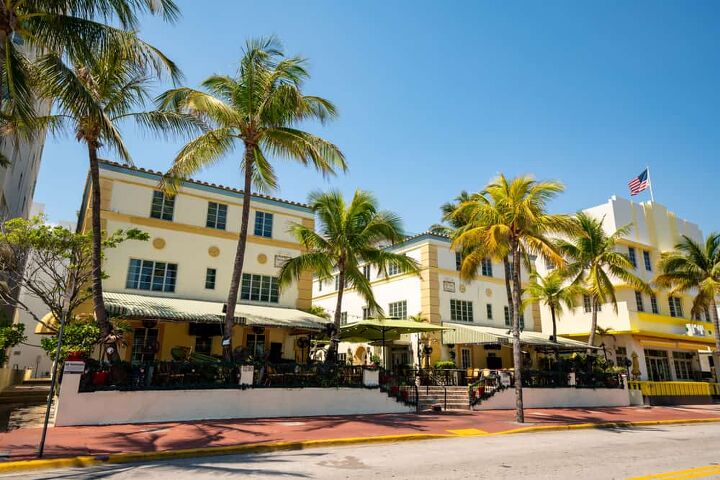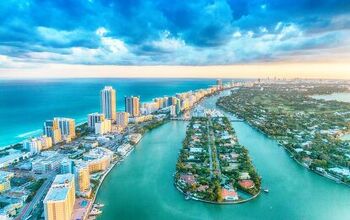The 15 Most Dangerous Neighborhoods In Miami: 2023's Ultimate List

When we think of Miami, we think of the beach and sparkling waters. Florida has been one of our favorite places in America to vacation for the last several years. However, some of us may want to live in this beautiful state. Well, if that’s the case, you should be careful of these top ten communities.
Based on FBI statistics, Overtown, Opa-Locka, Downtown, Wynwood, and Model City are the most dangerous neighborhoods in Miami. These neighborhoods rank highest per capita for both property and violent crimes on a constant basis, with between 96-295% higher crime occurrences than all of Miami. Other areas you should avoid include Upper Eastside, North Miami, and Bayside Harbor.
Overall, Florida offers people a unique living experience and each area. Miami offers impeccable shopping, clean beaches, and a lot of nightlife you can enjoy. It can be the perfect state to settle down and raise a family in the sun, but you will want to avoid these areas and look at different neighborhoods.
Related Content: Pros and Cons Of Living In Miami | Is Miami A Good Place To Live | Safest Neighborhoods in Miami | Most Dangerous Cities In Florida | Most Ghetto Cities In Florida
Determining The Worst Neighborhoods Of Miami
When we look for the worst neighborhoods, we want to also define why they may not be the best place to live. We want to determine each median income per household, the crime rate, type of crime, the chance of being a victim, and the population of an area.
These are the criteria we look at to understand the neighborhoods and why you may want to stay away.
The Top 15 Worst Neighborhoods Of Miami
Below, we go in-depth over the 10 worst neighborhoods of Miami so that you know where you should avoid them if you ever find yourself moving to or traveling through Miami.
1. Overtown
- Population: 9,640
- Violent Crime: 1,894
- Property Crime: 11,159
- Total Reported Crime: 13,053
This town has a rich historical aspect because it is one of Miami’s oldest black historical neighborhoods. Though the culture and history may make this town one of the most important historic towns, it is riddled with high crime rates and a lot of gun violence.
Walking here late at night is advised against due to the many gangs that live and hang out there. The crime rate is 145% over the national average, yet somehow still safer than 23% of Miami’s neighborhoods. This town keeps creeping up in the crime rate at least by 2% a year.
During the 2020 calendar year, there were 13,053 crimes reported. These crimes included murder, rape, assault, burglary, and auto theft.
Violent crimes made up 1,894 of the total, and property crime totaled 11,159. This all occurred in an area that had 9,640 residents at the time.
The median household income is $22,909, while the average home costs around $211,364, which is still a massive difference between income earned and what they have to pay to live in this neighborhood.
2. Opa-Locka
- Population: 16,245
- Violent Crime: 1,957
- Property Crime: 6,139
- Total Reported Crime: 8,096
Opa-Locka is a Miami suburb with a population of 16,245 people. Opa-Locka is located in Miami-Dade County, Florida. Residents in Opa-Locka enjoy a mix of urban and suburban living, with the majority of residents renting their homes.
There are numerous parks in Opa-Locka. Opa-Locka is a family-oriented community with liberal citizens. Opa-public schools are above average. However, the crime is horrible.
This neighborhood had a total of 8,096 reported cases of crime during the 2020 calendar year. This included everything from violent crimes to property crimes. According to the FBI statistics, there were 1,957 violent crimes and 16,139 property crimes.
3. Downtown
- Population: 30,065
- Violent Crime: 1,109
- Property Crime: 6,649
- Total Reported Crime: 7,758
Downtown Miami has a lot to offer visitors, but its crime rate is exceptionally high. It is higher than the national average by 308%, and it has one of the highest violent crime rates. There are a lot of bars and fun nightlife that may make this seem like an attractive urban setting.
Within a population of 30,065, there were a total of 7,758 reported crimes for the 2020 calendar year. These crimes included both violent and property crimes.
Of the total, there were 1,109 violent crimes and 6,649 property crimes reported per capita. Due to the size of the neighborhood, this is rather a high-crime rate.
The truth is most people can’t afford to live in this neighborhood, especially with how high the crime rate is. Most people choose to rent versus buy because the income is lower than expected. The average household income is $34,937, while the average home price is $357,679.
4. Wynwood
- Population: 17,923
- Violent Crime: 726
- Property Crime: 6,542
- Total Reported Crime: 7,268
In this neighborhood, a lot of crime goes unreported, so it actually may be worse than we know. This is not the best neighborhood to go for a casual stroll or to leave your car overnight. Many car break-ins and robberies happen in this area, making it an uneasy place to live.
There are very few pickpocketing and petty thieves, but this may be because it goes unreported often. Though this neighborhood is safer than 23% of Florida’s neighborhoods, the crime rate is still higher than the national average by 285%.
During the 2020 calendar year, there were 7,268 total crimes reported in Wynwood. This was within a population of 17,923, making it a high crime rate.
Of the total, there were 726 violent crimes and a whopping 6,542 property crimes reported per capita. These crimes included everything from murder and rape to residential burglary auto theft.
This neighborhood’s median home income is $28,484, while the median home value sold on the market is $375k. Most people who live in this neighborhood choose to rent, which can still be incredibly pricey compared to the average made.
5. Model City
- Population: 25,023
- Violent Crime: 1,781
- Property Crime: 4,710
- Total Reported Crime: 6,491
This is an area you will not hear mixed reviews about. It is a dangerous area to live in, and if you are walking or riding a bike, you should only do so during the day. If you are a female walking about, it is best to avoid this area because a violent crime against women is higher than the national average.
This is known as Liberty city and is filled with crime on almost every block. The household median income can be as low as $9,601 per household, while the median home value is 280k.
There is a massive gap in what people make versus what they pay for homes. Money isn’t everything, but a low poverty rate can affect the safety of a neighborhood.
According to FBI statistics, there were a total of 6,491 reported crimes. These crimes included everything from murder and rape to property-based incidents.
During the 2020 calendar year, property crimes outweighed violent crimes. There were 1,781 violent crimes reported and 4,710 property crimes per capita.
6. Upper Eastside
- Population: 7,725
- Violent Crime: 697
- Property Crime: 5,548
- Total Reported Crime: 6,245
Upper Eastside crime rates are much higher than the national average. In fact, it is 230% higher than the national average, making it an incredibly unsafe place to live. However, one of the great things about living in this area is that the police are very responsive and try to keep you as safe as possible.
The pickpocket rates are still high, and petty theft happens often. Still, overall, this is one of the safer neighborhoods to walk around in.
According to the FBI, there were a total of 6,245 reported crimes in the Upper Eastside during the 2020 calendar year. These crimes included everything from murder to property-based incidents.
However, property crime far surpassed violent crimes. There were 697 violent incidents and 5,548 property crimes reported per capita. The neighborhood had 7,725 residents at this time.
The median household income is $35,196, while the median home value is $367,000. It has another wide gap between the average income earned and the amount they have to pay for a house.
7. North Miami
- Population: 62,158
- Violent Crime: 762
- Property Crime: 1,382
- Total Reported Crime: 3,944
During a typical year, the crime rate of North Miami Beach is 34.06 per 1,000 residents. Residents of North Miami Beach often perceive the city’s south end to be the safest.
In the central neighborhoods of North Miami Beach, your chances of becoming a victim of crime are as high as 1 in 21, while in the south, your chances are as low as 1 in 37.
In the 2020 calendar year, there were 3,944 total crimes reported in North Miami. This happened in a community of 62,158 people. While the crime rate is not high, it is still existent.
Out of the total, there were 762 violent crimes and 1,382 property crimes reported per capita. Murder and rape, as well as house burglary and auto theft, were among the crimes committed.
8. Bayside Harbor
- Population: 21,854
- Violent Crime: 667
- Property Crime: 4,211
- Total Reported Crime:4,878
The port is a well-known tourist destination. People enjoy renting boats or simply relaxing and taking in the scenery. However, be cautious because you could be robbed by a pickpocket. Tourists are easy prey because they stand out like a sore thumb, so try to blend in as much as possible.
During the 2020 calendar year, there were a total of 4,878 reported crimes in Bayside Harbor, according to FBI stats. These offenses ranged from murder to property-related actions.
Property crime, on the other hand, significantly outnumbered violent offenses. Per capita, 667 violent occurrences and 4,211 property offenses were reported. At the time, the community had 21,854 residents.
9. Miami Gardens
- Population: 112,514
- Violent Crime: 782
- Property Crime: 2,775
- Total Reported Crime: 3,557
During a typical year, the crime rate in Miami Gardens is 29.64 per 1,000 residents. Residents in Miami Gardens perceive the northwest section of the city to be the safest.
In Miami Gardens, your chances of becoming a victim of crime can range from 1 in 26 in southwest neighborhoods to 1 in 58 in northwest neighborhoods.
There were 3,557 crimes reported in the 2020 calendar year. Murder, rape, assault, burglary, and auto theft were among the offenses committed.
Property crime accounted for 2,775 of the total, while violent crimes accounted for 782 of the total. All of this happened in a neighborhood with a population of 112.514 people at the time. While this isn’t a high crime rate, it’s still concerning.
10. Little Haiti
- Population: 33,229
- Violent Crime: 1,056
- Property Crime: 3,444
- Total Reported Crime: 4,500
This neighborhood was initially meant for Caribbean immigrants like those from Haiti, and that is how it also got its name. This neighborhood is known as the ghetto, but you may also hear it called Lemon City.
The perks of this neighborhood are there is a ton of yummy Haitian food to try out and a rich culture to enjoy. However, there are some of Miami’s highest crime rates, and the place gets very sketchy at night. It has a lot of gun violence that will make you want to steer clear of this neighborhood. The crime rate is 132% higher than the national average.
There is a lot of unsafety for any women who walk around in this area. The median household income is around $40,948, while the houses value an average of $340,210. This is another area where the income is lower than the average price to live.
In Little Haiti, there were 4,500 total crimes reported in the 2020 calendar year. This occurred in a town with a population of 3,329, indicating a high crime rate.
There were 1,056 violent crimes and 3,444 property crimes reported per capita out of the total. Murder and rape were among the offenses committed, as were residential burglary and auto theft.
11. Allapattah
- Population: 48,321
- Violent Crime: 876
- Property Crime: 3,451
- Total Reported Crime: 4,327
This was once the Dominican residential village, and though it only has a few corners where the crime is highest, it is still deemed one of the unsafe places to live. The crime rate is 125% higher than the national average, and most people choose to look elsewhere for homes.
The crime rate has also been steadily increasing in this neighborhood by 2% each year. Though most of this neighborhood is safe to walk through during the day and night, there are a few streets that should be avoided at all costs, like 9th ave and 20th street.
In the 2020 calendar year, there were 4,327 total crimes reported in Allapattah. This happened in a community of 38,321 people, showing a concerning crime rate.
Out of the total, there were 876 violent crimes and 3,451 property crimes reported per capita. Murder and rape, as well as house burglary and auto theft, were among the crimes committed.
The median home income is only $19,141.50, which is way below what it would cost to live comfortably here. The average home value of Allapattah is $268,817. This leads to very little wiggle room with expenses and can drive some people to crime.
12. Little Havana
- Population: 56,682
- Violent Crime: 543
- Property Crime: 2,438
- Total Reported Crime: 2,981
Another neighborhood dedicated to immigrants was supposed to be for Cuban immigrants coming into the states. This neighborhood is deemed so dangerous by the residents they don’t feel safe walking around midday.
When night comes, you will find most people inside locked up in their homes for safety reasons. No one should be walking in this neighborhood alone at night. The household median income is $24,491, while the median home sold is $277.5k.
It is very hard for people to afford to live in this neighborhood and harder to afford living life, which can greatly impact the quality of life.
In Little Havana, there were 2,981 total crimes reported in the 2020 calendar year. This occurred in a town with a population of 56,682.
There were 543 violent crimes and 2,438 property crimes reported per capita out of the total. Murder and rape were among the crimes committed, as were residential burglary and auto theft.
13. Carol City
- Population: 5,885
- Violent Crime: 144
- Property Crime: 1,988
- Total Reported Crime: 3,232
With its high house values and low crime rates, Carol City, Florida, is one of the most affluent in the greater Miami-Dade area. Realtors interested in investing in a piece of Miami’s South Florida real estate market have listed it for sale in recent years.
In addition to the neighborhoods that make up the area, there are a few residential areas close to the Carol City area. Brickell, the city’s principal district; Fontainebleau; Sunny Isles; and Coral Gables are among them. All of these neighborhoods are part of the area’s significant real estate developments. However, the crime isn’t great.
During the calendar year 2020, there were 3,232 documented crime cases in Carol City. This comprised a wide range of offenses, from violent to property crimes. According to FBI statistics, there were 144 violent offenses and 1,988 property crimes.
14. South Coconut Grove
- Population: 7,956
- Violent Crime: 341
- Property Crime: 2,130
- Total Reported Crime: 2,471
You will hear mixed reviews when it comes to Coconut Grove and what you should be aware of is that there is a north and south. The North Coconut Grove is actually 55% safer than many other neighborhoods in Miami.
However, South Coconut Grove is one of the places where you may not want to walk around alone at night. The chance of being a victim of violent crime in this neighborhood is very high.
The median household income is $83,666, and the unemployment rate is the same as the national average. Ranked of a national average of 100, the cost of living in this area was 143. This can make it hard for most people to make ends meet and may make them feel the need to find other ways to pay rent.
During the 2020 calendar year, there were a total of 2,471 crimes reported. These crimes included everything from murder to property-based incidents. This occurred in a population of 7,956. Out of the total, there were 341 violent crimes and 2,130 property crimes per capita.
15. West Flagler
- Population: 49,734
- Violent Crime: 250
- Property Crime: 1,603
- Total Reported Crime: 1,853
Though you may be able to walk during the day and night, this is a neighborhood where females should have companions after 9 pm. The crime rate is higher than in many other neighborhoods, and burglary happens often.
Though there is an active police station, they do not seem to be as quick as the bad guys. West Flagler is safer than 65% of Florida’s neighborhoods, but there are still far safer neighborhoods to move to.
The household income is $26,176.70, while the median home value is $370,815. Many of the people living in this neighborhood cannot afford a mortgage for a house, let alone a rent bill every month.
West Flagler had a total of 1,853 reported cases of crime during the 2020 calendar year. This included everything from violent crimes to property crimes. According to the FBI, there were 250 violent crimes and 1,603 property crimes.
Wrapping It Up
There are many safer cities to live in, and Miami can be a wonderful place to live if you find the right community. Instead of these neighborhoods, check out areas like Coral Gables, Kendall, Pinecrest, Sunny Isles Beach, Brickell, and Coral Way, which are much safer.
Miami doesn’t have to be dangerous all around. After all, it is a place that can keep you warm all year long and feel like a welcoming home.
Related Guides

We are a team of passionate homeowners, home improvement pros, and DIY enthusiasts who enjoy sharing home improvement, housekeeping, decorating, and more with other homeowners! Whether you're looking for a step-by-step guide on fixing an appliance or the cost of installing a fence, we've here to help.
More by Upgraded Home Team



























